How Olive Oil Is Made: The Whole Process Explained
Olive Knowledge is a part of Amazon Associates. As an Amazon Associate, we earn from qualifying purchases. Read our Affiliate Disclosure to learn more.
If you have ever wondered about all the steps needed to make a bottle of high-quality olive oil, you’re in the right place.
I’ve been through the whole process multiple times, and decided to share with you a full olive oil production process. I’ll write it in a simple way so you can understand everything, even if you’re a complete beginner in the world of olives and olive oil.
Quick Answer:
- Olive oil production begins with harvesting olives at their green-ripe stage.
- Post-harvest, olives are quickly transported to mills to avoid oxidation.
- At the mill, olives are crushed into paste using modern crushers.
- Oil extraction from the paste occurs via horizontal centrifugation.
- Post-extraction, olive oil undergoes filtration to remove impurities.
- Finally, the oil is graded, tested, and bottled, remaining fresh for up to two years unopened.
1. Harvesting the Olives
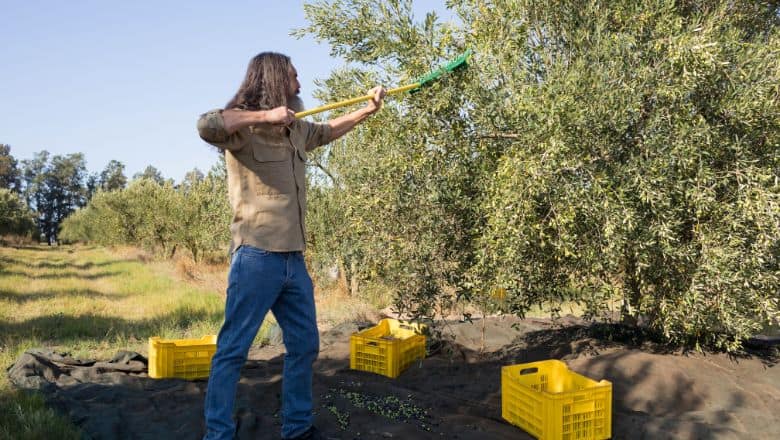
The process of olive oil production starts with harvesting the olives at their green-ripe stage when their juices turn cloudy.
Related: Is Picking Olives Hard?
Harvesting is usually from April to August in the Southern hemisphere and October to January in the Northern hemisphere. It starts with picking green olives and continues as the olives ripen to a dark color.
The quality of oil produced differs based on the color of the olives picked. Green olives produce light and slightly spicy oil with a fresh green aroma. As the olives get darker, the oil becomes fruitier and darkens slightly in color.
Olives oil is generally produced through a mechanized process. The two processes of olive harvesting widely used in most olive farms are mechanical vibration and the Vareo method.
Vareo olive harvesting involves the use of wooden rakes that are used to hit the olive fruits off the tree. These fruits fall onto harvesting nets underneath that protect them from falling to the ground.
Vareo harvesting gets the olives off the trees quickly but damages some of the ripe fruits and parts of the olive trees.
Therefore, most farmers harvest their olives using mechanized processes that vibrate them off the trees. This is done using tractors or mechanical tree shakers.
Once harvesting is complete, the olives are taken to the mill for further processing.
2. Transporting the Olives to The Mill
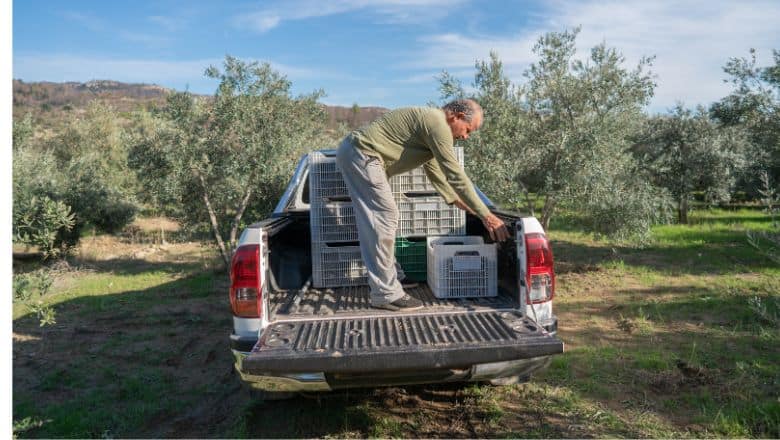
It is recommended that the olives are crushed within 24 hours of harvesting to avoid oxidation or fermentation. This guarantees the freshness of the olive oil produced and ensures its high quality.
Harvested olives must be transported to the mill in open cases to ensure the olive oil produced is as fresh as possible. This is referred to as same-day milling.
The olives are sorted, graded, washed, and weighed at the mill before being transported to the hoppers for crushing.
Related: How Much Olive Oil Can an Olive Tree Produce
During early harvest, 8 kgs of olives are required to make a liter of olive oil. However, once the olives ripen, only 4-5 kgs of olives are needed to produce a liter of olive oil.
3. Crushing and Pressing: Turning Olives into Paste
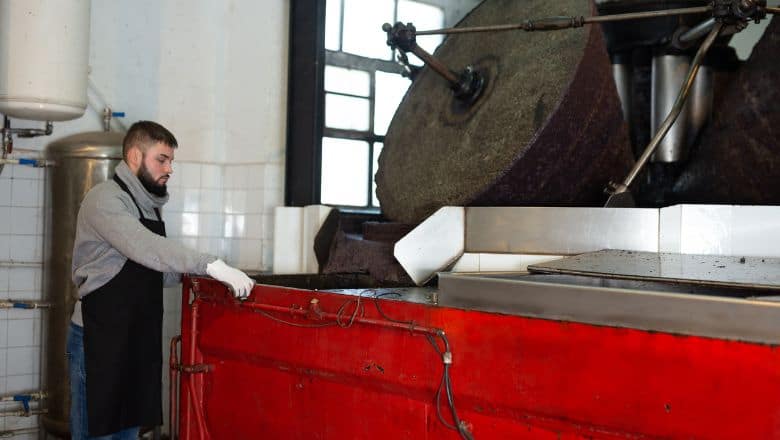
Crushing breaks down the flesh and seeds of the olive fruit into a paste to facilitate easy extraction of olive oil. Although stone mills are traditionally used to crush olives for oil extraction, metallic olive crushers are better.
These modern olive crushers are classified into disk, blade, or hammer crushers. The olive oil extracted using hammer crushers has more phenolic and o-tocopherol compounds. It also has a stronger pigment due to intense chlorophyll extraction.
Therefore most olive oil producers use metallic crushers for oil extraction.
During crushing, the washed olives are mashed into a paste and then transferred to a malaxer. This is where the homogenous olive paste or tapenade is shaken to separate the olive oil from the pulp.
4. Extracting the Oil: The Role of Modern Machinery
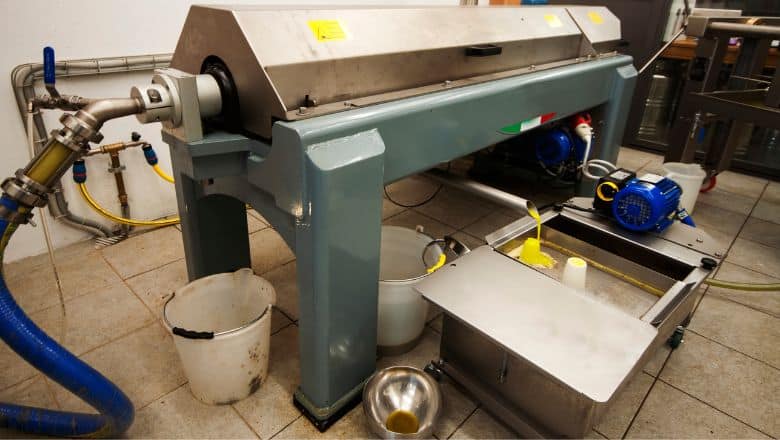
Olive oil extraction should occur within an hour of crushing and malaxing. The ideal temperature for olive oil extraction is below 27 °C. This is also the temperature to keep this oil to maintain its quality.
The extraction of the olive oil from the crushed and whipped olives occurs via horizontal centrifugation. This process requires less effort and produces high-quality olive oil that’s low in acidity.
Centrifugation involves the extraction of olive oil through a spinning motion. This separates the solid components of crushed olives called Pomace from Alpechin (the vegetable wastewater) and olive oil.
At the end of the centrifugation process, which takes 30-40 minutes, the olive oil is finally separated from the Pomace, Alpechin, and water.
5. Filtration: Ensuring Purity in Olive Oil
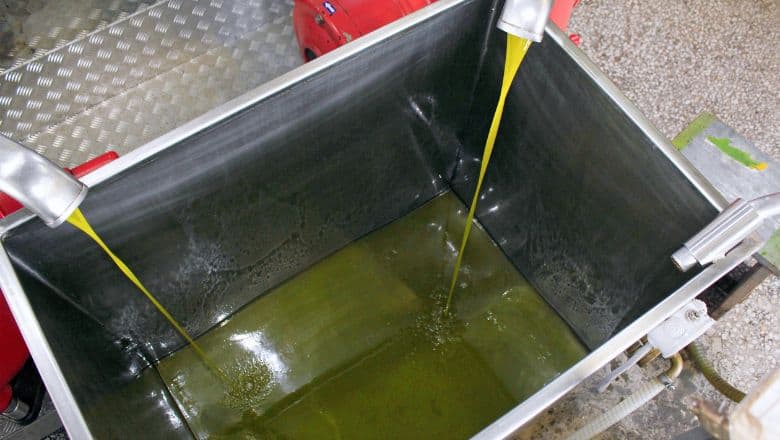
Once the centrifugation process is complete, the olive oil is set aside for filtration or decanting. This involves using gravity to separate any remaining impurities or solid materials from the pressed oil.
Quality control experts then evaluate and grade the freshly pressed olive oil based on organoleptic content and acidity levels. This is usually done through sensory analysis, where the oil is graded according to international standards.
Related: Filtered vs. Unfiltered Olive Oil: Comparison
The categories under which virgin olive oil is graded are Lampante Virgin, Virgin, and Extra Virgin Olive oil. The latter is the best type of olive oil because it contains the highest amounts of polyphenols.
The graded olive oil is then stored in stainless steel tanks away from oxygen and light at 18 degrees Celsius. Keeping the fresh olive oil in this way preserves it from degradation until it is ready for bottling.
6. Bottling and Packaging: The Final Stage
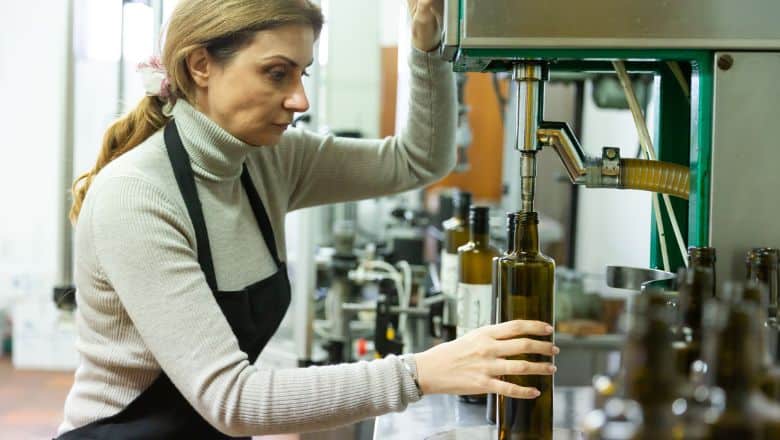
Graded olive oil is usually resampled and tested before bottling to ensure no oxidation has occurred. It is then packaged into different containers depending on the quality. This results in Extra virgin olive oil (EVOO), Virgin olive oil, and Regular olive oil.
Bottling and packaging of olive oil are done using gravity and vacuum bottle fillers in integrated oil bottling lines. The best types of containers for packaging olive oil are opaque glass bottles. They protect the olive oil from UV and heat damage, extending its shelf life.
Such well-processed and bottled olive oil can remain fresh for up to 2 years when unopened.
Bottom Line

This is the simple process of producing EVOO through cold processing. Extra Virgin Olive Oil is characterized by a spicy, peppery taste and has a high polyphenol content. Its appealing color and great aroma make it an excellent oil to use in cooking.
We’ve given you a simple rundown of the olive oil production process necessary for EVOO production. The simplicity of this process should give you an idea of why it’s the best plant oil you can buy.
If you’d like to buy the best olive oils from all around the world, I invite you to check out our Olive Oil Shop, where we’ve hand-picked the best olive oils from different countries, so you can pick the best of the best.
